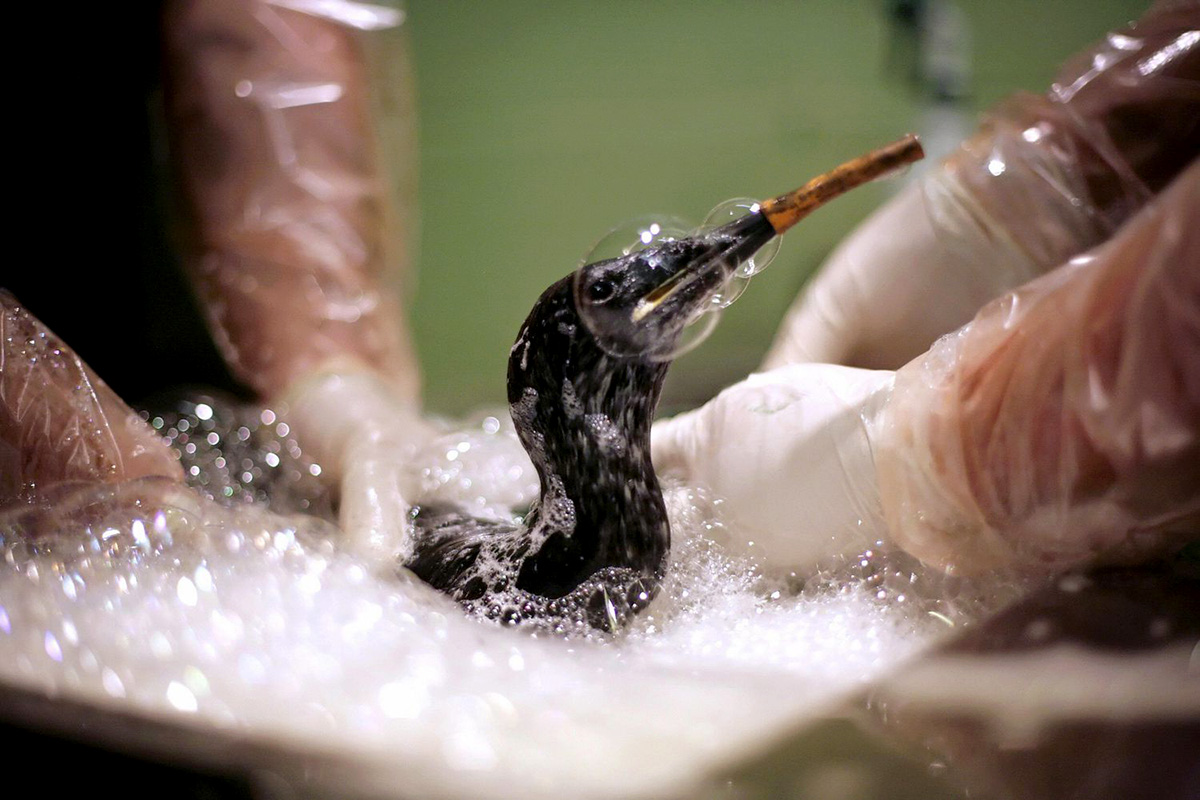Home>Finance>What Is One Of The Main Sources Of Funding For Wildlife Management In The US?


Finance
What Is One Of The Main Sources Of Funding For Wildlife Management In The US?
Modified: December 30, 2023
Discover how finance serves as one of the primary funding sources for wildlife management in the US, ensuring the preservation and protection of diverse species and their habitats.
(Many of the links in this article redirect to a specific reviewed product. Your purchase of these products through affiliate links helps to generate commission for LiveWell, at no extra cost. Learn more)
Table of Contents
Introduction
When it comes to managing the diverse wildlife populations present in the United States, funding plays a vital role. From conservation efforts to habitat restoration, the costs associated with wildlife management can be significant. So, where does the money come from?
One of the main sources of funding for wildlife management in the US is the Federal Aid in Wildlife Restoration Act, also known as the Pittman-Robertson Act. Enacted in 1937, this legislation has provided crucial financial support for various wildlife conservation initiatives over the years.
Under the Pittman-Robertson Act, a portion of the funds collected from excise taxes on firearms, ammunition, and archery equipment is allocated towards wildlife restoration projects. These funds are distributed to state wildlife agencies, enabling them to tackle critical conservation challenges and preserve the nation’s natural heritage.
Additionally, state wildlife agencies receive grants for specific programs, and they also generate revenue through conservation fees and licenses. Combined, these funding sources create a sustainable financial framework for wildlife management and ensure the wellbeing of the country’s diverse wildlife populations.
In this article, we will delve deeper into the main sources of funding for wildlife management in the US, exploring the role of the Pittman-Robertson Act, how excise taxes contribute to wildlife conservation, the distribution of funds, the importance of state wildlife agencies and grants, as well as the role of conservation fees and licenses.
The Federal Aid in Wildlife Restoration Act (Pittman-Robertson Act)
The Federal Aid in Wildlife Restoration Act, more commonly known as the Pittman-Robertson Act, was signed into law in 1937 with the aim of supporting the conservation and management of wild game species and their habitats. This act plays a crucial role in providing financial resources to state wildlife agencies across the United States.
Under the Pittman-Robertson Act, a federal excise tax is imposed on firearms, ammunition, and archery equipment. The revenue generated from these taxes is then distributed to the states for wildlife restoration and management projects. The tax rate is currently set at 11% for firearms and ammunition, and 10% for archery equipment.
This act serves as a dedicated funding mechanism to ensure that wildlife conservation efforts receive consistent financial support. The funds are utilized for various purposes, including habitat restoration, species recovery, research, public access improvements, and wildlife education programs.
One key aspect of the Pittman-Robertson Act is the provision that states must match a percentage of the federal funds they receive. This requirement ensures that there is a shared responsibility in funding wildlife conservation efforts between the federal government and the states.
By leveraging the funds provided through the Pittman-Robertson Act, state wildlife agencies can carry out essential initiatives to manage and protect wildlife populations. These efforts not only benefit game species but also have broader ecological impacts by supporting biodiversity and preserving natural habitats.
Over the years, the Pittman-Robertson Act has proven to be instrumental in supporting wildlife restoration and management in the United States. It continues to provide vital resources for states to address the various challenges faced in conserving and protecting the nation’s wildlife resources.
The Role of Excise Taxes
Excise taxes play a significant role in funding wildlife restoration and management in the United States. Under the Pittman-Robertson Act, a portion of the revenue generated from excise taxes on firearms, ammunition, and archery equipment is allocated towards wildlife conservation efforts.
Firearm and ammunition manufacturers are required to pay an excise tax of 11% on the sales of handguns, rifles, shotguns, and ammunition. Similarly, a 10% tax is imposed on the sale of archery equipment.
The revenue generated from these taxes is dedicated to supporting wildlife conservation projects, including habitat restoration, research, law enforcement, and public education initiatives. The funds are distributed to state wildlife agencies, who are responsible for managing and protecting wildlife populations within their respective jurisdictions.
Excise taxes provide a sustainable funding source for wildlife management since they are directly tied to the purchase of firearms, ammunition, and archery equipment. As the sales of these items fluctuate, the amount of revenue generated through excise taxes also varies accordingly.
The direct correlation between excise taxes and wildlife conservation creates a unique partnership between the shooting sports industry and conservation organizations. Those who participate in hunting and shooting activities contribute directly to the preservation and management of wildlife resources through their excise tax payments.
It is worth noting that the Pittman-Robertson Act has been highly successful in generating substantial revenue through excise taxes. Since its inception, billions of dollars have been collected and distributed to support wildlife conservation efforts across the country.
The role of excise taxes in funding wildlife management cannot be overstated. It provides a consistent stream of revenue that enables state wildlife agencies to implement necessary conservation measures and ensure the long-term sustainability of wildlife populations in the United States.
Distribution of Funds
The funds generated through excise taxes on firearms, ammunition, and archery equipment are distributed to state wildlife agencies based on a specific formula laid out in the Pittman-Robertson Act. This formula takes into account the land area and the number of licensed hunters in each state.
The U.S. Fish and Wildlife Service (USFWS) is responsible for administering the distribution of funds to the state wildlife agencies. Annually, the USFWS calculates the allocation for each state, taking into consideration the eligible land area and the number of paid hunting license holders and paid license holders who are either residents or non-residents.
While the exact formula may vary slightly over time, the primary objective is to ensure that each state receives an equitable share of the funds for wildlife restoration and management. This approach recognizes that different states have varying wildlife populations and conservation needs.
The funds received by state wildlife agencies are then utilized for a wide range of activities. These may include habitat improvement projects, species monitoring and research, law enforcement efforts, public education programs, and the acquisition and management of wildlife management areas.
Notably, the Pittman-Robertson Act requires states to match a percentage of the federal funds they receive. The matching requirement ensures that state wildlife agencies have a vested interest in wildlife conservation and actively contribute to the funding efforts.
Overall, the distribution of funds under the Pittman-Robertson Act follows a systematic approach that aims to allocate resources in a fair and equitable manner. This ensures that wildlife conservation efforts are adequately supported across the nation, facilitating the sustainable management of wildlife populations and their habitats.
State Wildlife Agencies and Grants
State wildlife agencies play a pivotal role in wildlife management and conservation efforts within their respective states. These agencies are responsible for implementing programs and initiatives that promote the sustainable use and protection of wildlife resources.
One of the key sources of funding for state wildlife agencies is through grants provided by organizations and federal agencies. These grants offer financial support for specific conservation projects and programs, supplementing the funds received through the Pittman-Robertson Act.
Grants may be awarded for a variety of purposes, including habitat restoration, research, wildlife monitoring, public education, and species management. They provide additional resources to tackle specific conservation challenges or to develop innovative approaches to wildlife management.
State wildlife agencies actively seek out grants from a range of sources, including non-profit organizations, conservation groups, private foundations, and government agencies such as the U.S. Fish and Wildlife Service. These grants can be highly competitive, and agencies must submit detailed proposals outlining their conservation goals and strategies.
Grant funding provides state wildlife agencies with the flexibility to address emerging conservation issues and to target specific species or habitats that require immediate attention. It allows them to collaborate with other organizations and agencies and leverage resources to maximize conservation impact.
Moreover, grants contribute to fostering partnerships between state wildlife agencies, conservation organizations, and the private sector. This collaboration strengthens conservation efforts and promotes the sharing of knowledge and expertise in wildlife management practices.
By actively pursuing grants and securing additional funding sources, state wildlife agencies can expand their conservation efforts beyond what is possible with the Pittman-Robertson Act alone. This diversified funding approach allows for a more comprehensive and effective approach to wildlife management and conservation.
Conservation Fees and Licenses
Another important source of funding for wildlife management in the US comes from conservation fees and licenses. These fees are collected from individuals who engage in hunting, fishing, and other recreational activities related to wildlife.
State wildlife agencies require individuals to obtain licenses and permits to participate in hunting, fishing, trapping, and other outdoor activities. These licenses come with a fee, which varies depending on factors such as residency, age, and the type of activity being pursued.
The revenue generated through these fees is then utilized by state wildlife agencies to support various conservation initiatives. These funds are critical in managing wildlife populations, conserving habitats, conducting research, and enforcing regulations to ensure sustainable resource use.
The fees collected from hunting licenses, for example, contribute directly to the management and conservation of game species. This includes activities such as land acquisition, habitat improvement projects, population monitoring, and enforcement of hunting regulations.
In addition to hunting licenses, fishing licenses also play a significant role in funding fishery management and conservation efforts. The fees collected from fishing licenses are used to stock fish, manage aquatic habitats, enforce fishing regulations, and provide public access to fishing sites.
It is important to note that the revenue generated from conservation fees and licenses remains within the state where they are collected. This ensures that the funds are specifically allocated to support wildlife management efforts within that state.
Conservation fees and licenses not only provide essential financial support for wildlife management but also serve as a way to promote responsible and sustainable outdoor recreation. By obtaining a license, individuals contribute to the preservation of wildlife and habitats while enjoying recreational activities in a regulated and sustainable manner.
Together with other funding sources such as the Pittman-Robertson Act and grants, conservation fees and licenses create a comprehensive financial framework that supports wildlife management and conservation initiatives across the United States.
Conclusion
Funding plays a vital role in supporting the management and conservation of wildlife resources in the United States. The main sources of funding for wildlife management include the Federal Aid in Wildlife Restoration Act (Pittman-Robertson Act), excise taxes, grants, and conservation fees and licenses.
The Pittman-Robertson Act has been instrumental in providing consistent financial support for wildlife restoration projects. Through the imposition of excise taxes on firearms, ammunition, and archery equipment, the Act ensures a dedicated funding mechanism for wildlife conservation efforts.
Excise taxes, collected from the sale of these items, create a direct link between the shooting sports industry and wildlife conservation. The revenue generated through these taxes is distributed to state wildlife agencies, enabling them to implement essential conservation initiatives.
In addition to the Pittman-Robertson Act, state wildlife agencies actively pursue grants to secure additional funding sources. These grants allow for targeted conservation efforts and collaboration with other organizations and agencies to maximize impact.
Conservation fees and licenses further contribute to wildlife management funding. The revenue obtained from these fees supports critical wildlife conservation and management activities, while also promoting responsible outdoor recreation.
In conclusion, the combination of the Pittman-Robertson Act, excise taxes, grants, and conservation fees and licenses creates a comprehensive financial framework for wildlife management in the United States. These funding sources ensure the preservation of wildlife populations, the restoration of habitats, and the sustainability of outdoor activities for generations to come.














